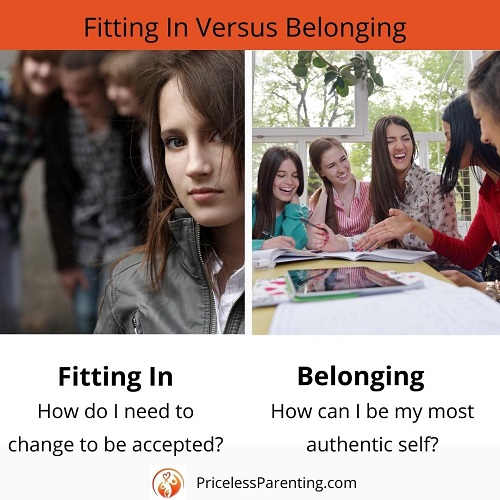Learning How to Fit into Peer Groups And Find Friends
by Kathy Slattengren, M. Ed., Priceless Parenting (sign up for monthly parenting newsletter and receive 20+ printable charts for kids and parents)
(listen to article read by the author)

We all have a deep need for connection with other people. Psychologist Alfred Adler declared that belonging, feeling a sense of connection, is one of the primary motivators of behavior. Your children are no exception; they too need to feel a sense of belonging.
Threatening to Remove Connection
When children want to hurt others, one of the primary ways they do it is by threatening to remove connection. Even young children know the power of saying things like:
- "I'm not your friend anymore"
- "I don't want to play with you."
- "You're not invited to my birthday party!"
- "I hate you!"
Words can really hurt. Children need help learning to express anger or frustration in healthier ways rather than threatening to no longer be friends.
Finding Good Friends
One of the most complex tasks of growing up is figuring out how to fit into the peer group. If your child struggles to fit in, it can be agonizing for both you and your child. You would like to protect your child and yet you really have limited abilities within your child's peer group.
Is there any way you can help? Mary was concerned about how her grade school daughter, Samantha, was struggling to find friends at her new school. Mary decided to try to help by asking Samantha who she thought might be a good friend and why. After she identified three girls, Mary helped Samantha invite each girl over for either a play date or to go somewhere fun. Spending one-on-one time with each girl helped Samantha grow closer to those girls.
Mary also thought it would help Samantha to have a group of friends outside of school. Since Samantha had shown an interest in dancing, Mary helped her find a dancing class where she met a number of girls who had similar interests. It was a slow process but eventually Samantha started making a few good friends.
Learning to Fit Into Peer Groups
Children can struggle to fit in for a variety of reasons. In his book
The Boy Who Was Raised as a Dog,
Dr. Bruce Perry describes Peter, a first grade boy whose parents adopted him from Russia. Peter was socially awkward due to the fact he spent his first three years of his life in a large orphanage primarily stuck in a crib. Because he didn't get the loving interactions he needed early on, his social skills were far behind other children his age.
Dr. Perry realized that Peter's peers were in the best position to help him learn these social skills so he spoke to Peter's first grade class. He explained why Peter's brain was different than theirs and how they could help Peter. After that talk, "The brightest and strongest children in his class took a special interest in him and their leadership made all the difference. They included him, protected him and, ultimately, provided therapeutic experiences that helped Peter catch up."
Differences Between Belonging and Fitting In
The terms "belonging" and "fitting in" are sometimes used interchangeably. However, they are very different concepts.
In Brené Brown's book
The Gifts of Imperfection she states, "One of the biggest surprises in this research was learning that fitting in and belonging are not the same thing, and, in fact, fitting in gets in the way of belonging. Fitting in is about assessing a situation and becoming who you need to be to be accepted. Belonging, on the other hand, doesn't require us to
change who we are; it requires is to
be who we are."
The best gift you can give your children is a strong sense of love and belonging within your family. When you love and appreciate your children for who they are, they can be authentic. Children shouldn't have to fake it to belong at home.
Knowing When to Fit In
When's the last time you remember holding back on showing your true colors in order to fit into a group? Quite a bit of knowledge and experience goes into knowing how much to reveal to whom. How do children learn these complex rules?
One way they learn is from us. When my son was 3-years-old he wanted to have his nails painted just like his 6-year-old sister. So I painted them. I then heard disparaging remarks about how his masculinity would be affected by having his nails painted. To fit in better while still meeting his desire to have his nails painted, I did not let him choose "girly" pink or purple colors. It was his first lesson in fitting in.
Children also learn about how much to share through experience. What is ok to share with whom? Who can you trust with your most personal information?
Common Sense Media reports 20% of teens have shared naked pictures of themselves with their boyfriends or girlfriends through sexting. These pictures are often forwarded to many others. The teen then feels betrayed by the one they trusted with their personal information. It's a painful lesson.
Belonging with Family and Friends
The tricky part is that real connection requires authenticity. Your children will likely go through many challenging times as they figure out who they can trust with their genuine feelings, desires and beliefs.
It is critical to your children's psychological wellbeing that they have a sense of love and belonging from you. They need to feel loved and accepted by you for who they are. Home is then the ideal rock your children can return to whenever they want to relax and just be themselves.